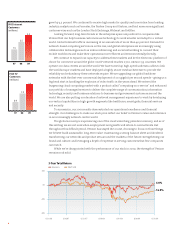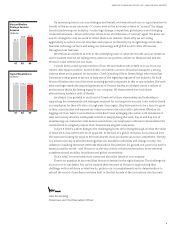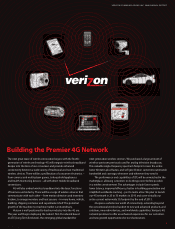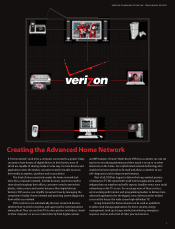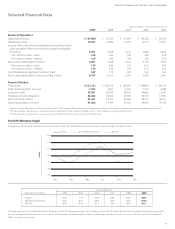Verizon Wireless 2009 Annual Report Download - page 16
Download and view the complete annual report
Please find page 16 of the 2009 Verizon Wireless annual report below. You can navigate through the pages in the report by either clicking on the pages listed below, or by using the keyword search tool below to find specific information within the annual report.
approximately $4 billion for Verizon’s Wireline segment. The Company
does not currently have plans to divest its remaining switched or special
access lines.
Our results of operations, financial position and sources and uses of cash
in the current and future periods reflect our focus on the following stra-
tegic imperatives:
Revenue Growth – To generate revenue growth we are devoting our
resources to higher growth markets such as the wireless voice and data
markets, the broadband and video markets, and the provision of strategic
services to business markets, rather than to the traditional wireline voice
market. During 2009, consolidated revenue growth was 10.7% compared
to 2008, primarily due to the acquisition of Alltel Corporation (Alltel) in
January 2009 and higher revenues in growth markets partially offset by
lower revenue in the Wireline segment. We continue developing and
marketing innovative product bundles to include local, long distance,
wireless, broadband data and video services for consumer and gen-
eral business retail customers. We anticipate that these efforts will help
counter the effects of competition and technology substitution that have
resulted in access line losses, and will enable us to continue to grow con-
solidated revenues.
Market Share Gains – In our wireless business, our goal is to continue
to be the market leader in providing wireless voice and data commu-
nication services in the U.S. We are focused on providing the highest
network reliability and innovative products and services such as Mobile
Broadband and our Evolution-Data Optimized (EV-DO) service. We also
continue to expand our wireless data, messaging and multi-media offer-
ings for both consumer and business customers. With our acquisition of
Alltel, we became the largest wireless provider in the U.S. as measured
by the total number of customers and revenues. In our wireline business,
our goal is to become the leading broadband provider in every market in
which we operate. During 2009, as compared to 2008:
• Domestic Wireless total customers increased 26.6% to 91.2 million as of
December 31, 2009, primarily due to the acquisition of Alltel;
• average revenue per customer per month (ARPU) from service rev-
enues decreased by 1.6% to $50.77, primarily due to the inclusion of
customers acquired in connection with the acquisition of Alltel; and
• total data ARPU grew by 17.9% to $15.20 due to increased use of
Mobile Broadband, e-mail and messaging.
As of December 31, 2009, we passed 15.4 million premises with our high-
capacity fiber optics network operated under the FiOS service mark.
During 2009, at Wireline:
• total broadband and video revenues exceeded $6 billion;
• we added 547,000 net wireline broadband connections, including
952,000 net new FiOS Internet subscribers, for a total of 9.2 million
connections, including 3.4 million FiOS Internet subscribers; and
• we added approximately 943,000 net new FiOS TV subscribers, for a
total of 2.9 million FiOS TV subscribers.
With FiOS, we have created the opportunity to increase revenue per
customer as well as improve profitability as the traditional fixed-line
telephone business continues to decline due to customer migration to
wireless, cable and other newer technologies.
We are also focused on gaining market share in the enterprise business
through the deployment of strategic service offerings – including expan-
sion of our VoIP and international Ethernet capabilities, the introduction
of video and web-based conferencing capabilities, and enhancements to
our virtual private network portfolio. In 2009, revenues from total strategic
services grew 4.3% compared to 2008 led by sales of IP data services.
OVERVIEW
Verizon Communications Inc. (Verizon, or the Company), is one of the
world’s leading providers of communications services. Our domestic
wireless business, operating as Verizon Wireless, provides wireless voice
and data products and services across the United States (U.S.) using one
of the most extensive and reliable wireless networks. Our wireline busi-
ness provides communications products and services, including voice,
broadband data and video services, network access, long distance and
other communications products and services, and also owns and oper-
ates one of the most expansive end-to-end global Internet Protocol (IP)
networks. Stressing diversity and commitment to the communities in
which we operate, we have a highly diverse workforce of approximately
222,900 employees.
In the sections that follow, we provide information about the important
aspects of our operations and investments, both at the consolidated and
segment levels, and discuss our results of operations, financial position
and sources and uses of cash. In addition, we highlight key trends and
uncertainties to the extent practicable. The content and organization of
the financial and non-financial data presented in these sections are con-
sistent with information used by our chief operating decision maker for,
among other purposes, evaluating performance and allocating resources.
We also monitor several key economic indicators as well as the state of
the economy in general, primarily in the United States where the majority
of our operations are located, in evaluating our operating results and
assessing the potential impacts of these trends on our businesses. While
most key economic indicators, including gross domestic product, affect
our operations to some degree, we historically have noted higher cor-
relations to non-farm employment, personal consumption expenditures
and capital spending, as well as more general economic indicators such
as inflationary or recessionary trends and housing starts.
Beginning in 2009, we changed the manner in which the Wireline seg-
ment reports Operating revenues to align our financial presentation
to the continued evolution of the wireline business. Accordingly, there
are four revenue-producing lines of business within the Wireline seg-
ment: Mass Markets, Global Enterprise, Global Wholesale and Other.
Mass Markets includes consumer and small business revenues. Global
Enterprise includes retail revenue from enterprise customers, both
domestic and international. Global Wholesale includes wholesale rev-
enues, both domestic and international, including switched and special
access revenues, local wholesale and wholesale services from our global
and IP networks. Other primarily includes operator services, payphone
services and revenues from the former MCI mass markets customer base.
In providing services to former MCI mass market customers, we princi-
pally use other carriers’ networks.
On May 13, 2009, we announced plans to spin off a newly formed sub-
sidiary of Verizon (Spinco) to our stockholders. Spinco will hold defined
assets and liabilities of the local exchange business and related lan-
dline activities of Verizon in Arizona, Idaho, Illinois, Indiana, Michigan,
Nevada, North Carolina, Ohio, Oregon, South Carolina, Washington, West
Virginia and Wisconsin, and in portions of California bordering Arizona,
Nevada and Oregon, including Internet access and long distance ser-
vices and broadband video provided to designated customers in those
areas. Immediately following the spin-off, Spinco plans to merge with
Frontier Communications Corporation (Frontier) pursuant to a definitive
agreement with Frontier, and Frontier will be the surviving corporation.
Consummation of the transactions contemplated in the agreements is
subject to customary closing conditions. The merger will result in Frontier
acquiring approximately 4 million access lines and certain related busi-
nesses from Verizon, which collectively generated annual revenues of
14
Management’s Discussion and Analysis
of Financial Condition and Results of Operations
VERIZON COMMUNICATIONS INC. AND SUBSIDIARIES


